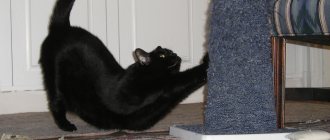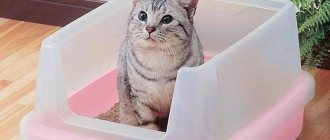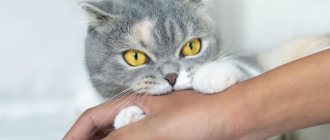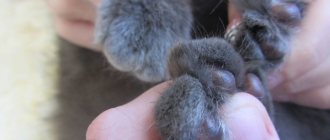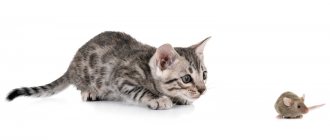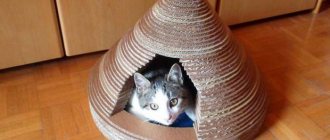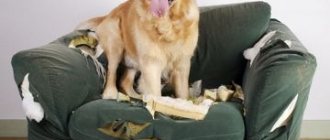Charming and affectionate cats bring to our home not only joy, but also some problems associated with the wayward nature of small predators. These animals have their own habits, which do not always please the owner. All cats, without exception, sharpen their growing claws on certain objects, and very often their choice falls on walls decorated with beautiful wallpaper. In our article we will discuss the question of how to wean a cat from tearing wallpaper. Useful tips from experienced breeders will help you raise an obedient pet with decent behavior.
Causes and physiology of cats
The natural procedure for all representatives of the cat family is to sharpen growing claws. They can only be ground down using a specific object: upholstered furniture, carpet, wood plank, rough wall or scratching post (a special accessory for cats).
If a cat in the house begins to damage furniture or walls, the owner looks for all possible ways to solve the problem. Some people who do not want to engage in educational work simply get rid of the kitten, handing it over to good hands, to an animal nursery, or simply throwing it out into the street.
We strongly do not recommend doing this! A small animal performs such an act out of natural instinct, and if you raise your pet correctly, you can preserve not only the walls and furniture in the house, but also friendly relations with your furry family member and your own conscience.
Before looking for the answer to the question - how to wean a cat from scratching wallpaper, let's look at the main reasons that prompt the animal to such actions:
- The cat gets rid of the keratinized layer of old claws, in the place of which new ones are formed.
- During the sharpening process, all the muscles of the animal are involved, which can be compared to a good physical warm-up.
- Sharpening claws is a genetically inherent skill, similar to the hunting and defensive instinct.
- The smell of the cat's sweat glands remains on scratched walls and furniture, which allows the pet to “mark” its territory.
- The scratching process relieves stress and nervous tension. This unpleasant procedure for humans brings a lot of pleasure to cats who want to get rid of negative emotions and personal experiences.
As we can see, scratching surfaces for representatives of the feline species is a physiological need that is genetically determined. It is possible to retrain a kitten, but this will require your desire, time and the right approach to raising a furry friend.
How to wean a cat from a bad habit
There are several ways to stop a cat from tearing up furniture and wallpaper. For example, you can train an animal using commands or signals. To do this, it is recommended to use objects that make loud sounds (rattles, metal objects, balloons), as well as to say “no”, “no”, “fu” or hiss at your pet. It is recommended to use these measures before attempting to sharpen the claws or in the first seconds of this process.
Characteristics and properties of foam rubber for furniture, tips for choosing
For the pet, these actions will be associated with punishment, which will help to wean the cat from tearing up furniture. Another way to protect your home set is with adhesive pads. They can be attached to any surface.
scratching post
The simplest and most effective way to stop a cat from scratching furniture and wallpaper is to purchase a scratching post for him. There are many options on the market, there are both individual columns and built-in houses, entire complexes for games. It is worth purchasing a scratching post made of a material more similar to the one your pet has chosen in the house. For installation, you need to select a free corner or another area of the apartment. A place for the animal's needs can be made from a board, carpet, twine or regular clothesline. This requires wrapping the material around a rigid and stable base.
To accustom your pet to a scratching post, you can use catnip or valerian (infusion). This area is first coated with the substance, after which it is brought to the animal’s device. It is necessary to start playing with the cat so that it releases its claws. After this, her paw needs to be brought to the structure, copying the natural sharpening. It is recommended to repeat the process until the animal gets used to it and begins to do it on its own. The scratching post for cats needs to be made large enough so that the pet can fully stretch out.
Equipment for a personal sleeping area
To prevent your cat from tearing up furniture and wallpaper, it is recommended to make a personal place for him to sleep. This will reduce the animal's stress if people have multiple pets. You can use special houses, sun loungers or ordinary cardboard boxes. You need to choose a suitable space for installation and accustom the cat to it using training or aromatic substances (mint, valerian).
How and how to clean upholstered furniture at home, the best ways
It is recommended to place the pet's house near a place where people are often present, since cats love company and rarely tolerate loneliness. It is necessary to wean other animals from trying to occupy someone else's house and equip a separate one for each. This will reduce the number of stressful situations for cats and help prevent property damage.
Water use
You can use a spray bottle if you need to stop your cat from scratching furniture, as animals are afraid of water. To do this, you need to spray the device into his face or onto his fur. It is important to avoid getting liquid into your cat's ears, as it can cause disease or inflammation. You can add various aromatic substances to the water that repel pets, for example, citrus juice or spices. You should spray water on animals very carefully, as you can get into household appliances or wet the wallpaper.
If you splash a cat after the claw point, he will not understand why he was punished.
Wallpaper protection
If an animal scratches wallpaper or furniture in one place, then you should get fabric covers. They are easy to attach to the surface using nails, glue, and paper clips. The damaged area can be covered with adhesive tape. It is subtle, but effective against cats, as they really don’t like it when something sticks to them. You can also use a woven cotton rug that is attached to a wall or furniture. It, like fabric, will allow your pet to sharpen its claws without damaging interior items.
It is recommended to choose liquid, slippery wallpaper or replace old ones with them. This way, the cat will have nothing to cling to, and it will stop tearing at the wall. The most drastic solution may be to cover the damaged areas with tiles or decorative plaster.
We stop scratching furniture: sprays, Velcro, covers
For sharpening its claws, a cat can choose not only walls with beautiful wallpaper, but also upholstered furniture, which is very convenient for carrying out these procedures. To protect your property from damage, experts recommend doing the following:
- Monitor the growth of your cat's claws and trim them in a timely manner using a special tool for safe trimming (can be purchased at any pet store).
- Use essential oils or lemon and orange scent repellent sprays. To treat surfaces, you can use a spray bottle with a spray. Use the same accessory with clean water to repel a cat who is keen on scratching furniture. The main thing is to detect the pet’s cunning intent in time and not allow it to damage the upholstery of a piece of furniture.
- If your cat has become accustomed to picking up furniture in a certain room, try not to leave it alone in that part of the house.
- Educational conversations with a fairly smart animal won’t hurt either. Cats understand intonation well and react instantly when the owner says “no” in a threatening manner. Scold her for bad behavior, but under no circumstances use physical force!
- You can also use adhesive tape to remove interest from the furniture surface.
- Armchairs and sofas can be covered with covers made of elastic fabrics that are not suitable for sharpening growing claws.
Manipulation of claws: should we cut them or put on pads?
If the cat owner does not want to fight wall scratching using tape, rattles or a spray bottle to scare the cat away, experts recommend paying attention to the pet’s claws.
In order for the cat to tear less at walls and furniture, it is necessary to regularly trim growing claws, which is best done using a special nail clipper or entrust this procedure to an experienced professional in a veterinary clinic.
Another way to wean someone from scratching walls involves the use of special claw pads - anti-scratch pads. They are made of high-quality silicone, safe for the health of the cat. They are placed on the pet's claws, which eliminates the risk of damage to walls, furniture and other items in the house.
Anti-scratch pads are very easy to use. They have an imitated shape of an animal's claw. There is enough space inside the accessory to freely extend and retract the claws, so the cat feels quite comfortable with such pads.
As the claws grow and the stratum corneum moves away, the cap of the overlays comes off. If necessary, they are fixed again.
You can buy anti-scratch products at any pet store at an affordable price. Such pads should only be used at home.
Why does a cat tear up furniture and scratch wallpaper?
Seeing the destruction that a cat causes in an apartment, some owners, instead of thinking about how to wean the cat from tearing wallpaper, begin to cruelly punish the animal, not even suspecting that the main share of the blame lies with them.
Cats leave claw marks and pheromones on furniture.
It is important to understand why this happens in order to prevent further “raids” on furniture and wallpaper. These problems rarely arise for those who live “on the ground”: in private households, cottages, and dachas, where the animal can walk freely and independently choose a place where it can sharpen its claws.
Cats don’t tear up wallpaper on purpose, and they certainly don’t do it out of spite.
For those living in apartments, the problem of how to stop a cat from scratching wallpaper is very acute. According to experts, the sources of such behavior can be physiological, behavioral and psychological problems, which, however, can be solved.
Little kittens are taught by their mother cat, but it also happens that even older cats do not know the basic rules of behavior.
Physiology
Although the cat has lived next to humans for many millennia, it remains a predator at its core. Sharp claws are a necessary condition for readiness for attack, hunting or self-defense. And if the owner has not provided personal space for his pet, creating conditions so that the claws are always in order, he will certainly be punished for his inattention with torn wallpaper.
In nature, cats sharpen their claws on trees; in the absence of such in the apartment, they have to look for analogues.
In addition, there are purely physiological problems that must be taken into account when raising a cat:
- sharpening claws is a natural cat need - this way they get rid of the interfering layer of overgrown claws;
- In this unusual way they “mark” the boundaries of their territory;
- This procedure is combined with kneading the muscles that provide flexibility to the cat.
Cats can't help but sharpen their claws.
Psychological problems
Unfortunately, not everything can be explained and justified by physiology. Sometimes psychological problems arise that are associated with the emotional state of a furry friend. These animals are characterized by a rich palette of feelings and emotions: from joyful purring to angry hissing and energetic damage to furniture and wallpaper.
Upholstered or leather furniture, wallpaper - this is what a cat finds first when it does not have a special scratching post.
Moreover, if the cat is angry, he, despite the menacing shouts of his owners, will continue his “dirty deed” with even greater frenzy: in this way he relieves stress, the appearance of which has a variety of reasons:
- one of them is jealousy - cats are rarely indifferent to the need to share the owner’s love and attention with someone else, be it the owner’s dog or the owner’s child;
- anxiety associated with the appearance of an encroacher on the cat’s personal space or territory.
You can make a scratching post yourself or buy it at a pet store.
Behavioral reasons
One of the reasons for ugly behavior is insufficient attention from the owner. Poor care and lack of education can also contribute to violation of cat discipline. Some people believe that a cat that “walks on its own” does not require any training, which is not true.
Some breeders recommend spraying a new toy with a catnip solution.
Its absence is necessarily reflected in the animal’s habits. A small kitten does not understand what can and cannot be done in the apartment - this must be “explained” using available methods, without punishing the baby.
It is quite difficult to stop a cat from tearing up wallpaper.
If the owner initially did not pay due attention to this issue, it will be quite difficult to wean the cat from tearing up the wallpaper, and it will take a lot of time.
Let's remove claws once and for all!
Some owners, tired of regular property damage, agree to declawing surgery. This procedure is painful for the animal and has very adverse consequences:
- a cat without claws has poor coordination of movements;
- instinctively she may make attempts to climb to heights, which will lead to an inevitable fall and impact;
- not only the claws are removed, but also the phalanges of the fingers, which will negatively affect the overall health of the pet;
- After such an intervention, many cats develop problems with the spine and experience frequent pain in the spinal region;
- The operation is performed under general anesthesia, which is difficult for animals to tolerate.
You should also keep in mind that after declawing, your cat will not be allowed to go outside. If she is attacked by another cat or dog, she will not be able to fend for herself or climb to heights to avoid a deadly fight with a stronger opponent.
Scratching post as a way to preserve furniture
It is unacceptable to completely exclude the possibility of sharpening claws for a cat who does not leave the apartment or house! This process is simply vital for tailed pets. If you don’t know how to stop a cat from scratching wallpaper and don’t want to regularly change furniture or glue new wallpaper every year, purchase a special design for your furry family member - a scratching post.
The accessory is very convenient to use, does not take up much space in the house and is ideal for sharpening the stratum corneum of claws. Specialized stores for animals offer scratching posts of various types and shapes, from simplified configurations to the most original models, made in the form of animal figures or cozy houses for a kitten’s comfortable rest.
Remedies
In order to understand why a cat tears at the wallpaper, you need to take a closer look at the animal. This way the owner will understand how to wean her.
If the reason is psychological in nature, then everything is simple. It won't be difficult to stop a kitten from tearing up wallpaper. The owner needs to establish contact with his pet:
- Give him more attention, praise, talk to him.
- Tactile contact is also very important. Many cats need to purr on their owner's lap. This way the pet will be able to calm down, receive the missing attention, and the problem will go away on its own.
If the reason lies in the animal’s bad manners, then everything is more complicated. He has not yet developed his habits, and the owner acts as a mother cat. Sometimes it is enough to show the kitten once where and how to sharpen its claws, next time it will not make a mistake. An ill-mannered adult cat is unlikely to change its habits after the owner’s first remark.
There is a very effective method that can wean your pet from tearing wallpaper:
- Yu. Kuklachev's method . It consists of creating a homemade device from a plank and a glued piece of already familiar wallpaper, which the pet scratches with pleasure. The board is attached to the cat’s favorite place, then gradually moves away from it as far as possible. Thus, the owner is given the opportunity to regulate the location of the cat scratching post.
If this method does not work, more radical methods should be used:
- Noise . Cats react very strongly to loud noise. They get scared. Next to the corner that the cat is peeling, you need to place a jar of change and rattle it when the animal tries to misbehave.
- Spray. Cats are very afraid of water. If you spray it on your pet while trying to tear off the wallpaper, he will soon stop doing this in an unspecified place.
- Repellent smell . The smell of onions, citrus fruits, and vinegar is unpleasant for cats. But this method does not give a 100% result, because not every cat will be scared off by a strong smell. All pets are different.
The pet is no longer attracted to the corner with wallpaper, but the physiological needs have not gone away and it is still necessary to sharpen the claws. Before the cat scratches a new corner, you need to purchase a scratching post in a timely manner. These are ready-made, thoughtful, neat designs; they come in different sizes, shapes, and different price categories.
| It is recommended to observe the pet and choose according to the animal’s vertical or horizontal preferences in the matter of sharpening. If a cat tries to scratch on the carpet, then you should buy a floor-mounted scratching post (average cost - 400 rubles) or, better yet, a scratching post-bed |
| If your attempts are always aimed at something vertical, then you should choose a hanging nail scratcher or in the form of a column (average price - 700 rubles). A scratching post in the form of a column can be a good exercise machine for your pet, as it helps warm up and strengthen the muscles of the back and shoulders. |
| The ideal option would be to accustom your cat to a scratching post in the form of a house or play space. In this way, they will not only solve the main turning problem, but also occupy their free time or sleep. This will be extremely convenient, since cats most often tend to sharpen their claws after sleep. The only drawback of such nail scrapers is their high cost (from 2000 rubles and above). |
But how to attract your pet's attention to a new scratching post? There are a number of rules:
- Tight fixation of the scratching post. It should not fall, rattle, or scare the cat. Otherwise, he may not approach her again.
- Accommodation near your favorite place . You should gradually move the scratching post to a location convenient for the owner.
- Impregnation of a new accessory with mint or valerian oil . Cats really like this smell, they will definitely pay attention to the new piece of furniture in the form of a scratching post.
If these tips do not lead to the desired result, then the damaged corner can always be covered with furniture (if the interior allows). If not, then you need to choose what to seal it with. Decorative stone or tiles are perfect.
